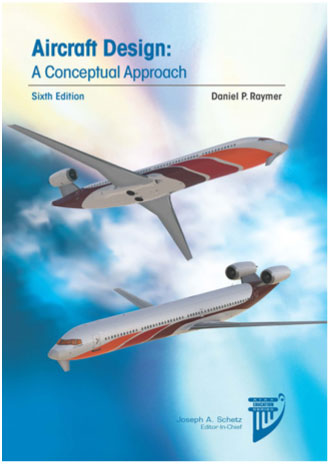
This extensively cited textbook – now issued in its Sixth edition – was first published 30 years ago. It has established a highly respected place in aeronautical technical literature, and the AIAA now claims more than 60,000 sales.
Raymer has described aircraft design as a separate discipline. What he means is borne out by this whole book that addresses the considerable array of factors to be considered during design – each not in detail, but fully enough for understanding, estimating and balancing against all the other factors.
The book gives a very good introduction to the iterative nature of the front end of the design process and to getting the main parameters in the right ‘ballpark’ based on fundamental principles and a digest of experience from existing designs. Raymer’s book is all about these early steps and is a remarkable compendium of the many aspects to be considered by the designer.
Design of aircraft is particularly challenging, not least because of the constant need to minimise weight within acceptable structural criteria. The task of fully designing an aircraft is considerable and involves much analysis. When committing to carrying out this task, it is prudent to establish a good optimal layout at the earliest opportunity. But how to do this when the detail is insufficiently defined for the full analyses that will be necessary to ensure the adequacy of the design? This is what conceptual design is all about; it uses data and experience from wherever it can be found and starts the multiple iterations that may lead to a final product.
The author points out that ‘the only thing that gets built (and actually flies) is the aircraft as defined by the layout geometry’. With respect to the external shape, a very helpful outline of classic conic lofting techniques is given for application to fuselage and lifting surfaces.
The book is remarkable for its scope of different types of aerial vehicle, from airships to hypersonic aircraft (the only significant class of aircraft that appears to be missing is the autogyro). As he addresses each design feature, Raymer outlines the different ways that the feature could be realised. Taken across the book, this makes for a quite comprehensive taxonomy of design solutions. While there is a bias towards military aircraft design, reflecting the author’s early career with Rockwell and Lockheed, there is good coverage for civil transport and general aviation too.
A high proportion of the book is devoted to capturing experience and lessons from the past to enable the designer to put numbers to the design. These include rules-of-thumb, formulae and coefficients from the literature (much from NACA/NASA reports and the USAF DATCOM). The author also provides parametric analyses that he has made of past designs.
Ways of finding an optimum design and criteria for judging it are laid out. Classical aircraft optimisation methods use parametric analyses. The text describes techniques for handling these, from carpet plots to multidisciplinary design optimisation (MDO), which is quoted as being suitable for systems where ‘in their design, everything influences everything else’.
Changes from earlier editions include an additional chapter discussing electric and hybrid propulsion replacing a shorter section in the previous edition. This is not aimed at how to design the power train, but how to integrate it into the study aircraft and optimise the design of that aircraft. Among other smaller additions is a reference to ‘railroad’ curves that, when applied to the lofted outer profile, may help to avoid premature boundary layer separation. The two full-length worked examples are as in earlier editions. Raymer continues to allude to his software package RDS (which remains at V6.3e as linked to the Fifth edition).
Raymer’s enthusiasm pervades the whole book. His style is succinct and conveys a lot of information. He generally gives a full verbal description of each subject topic and relationships between principal variables. He then summarises this in a formula giving the mathematical expression of the same relationships, suitable for arithmetic evaluation. Consequent observations and examples follow easily. With narrative so clear, even the less technically experienced reader should find it full of interest.
Raymer is old school and strongly holds to the view that a feel for what is being calculated is an essential precursor to just loading data into a computer program. As he says (referring to structural matters), ‘many of the methods presented are no longer in regular usage, having been supplanted by finite element methods. The older methods are useful, however, for approximating the correct answer to ensure that the finite element methods are in the right ‘ballpark’. And, of course, this is particularly relevant in the early conceptual phase.
The book is supported by a considerable array of references as befits the amount of design data provided. Although the author has not fully listed the examples used in his parametric plots, they provide good examples for students to emulate in gathering and exploiting data pertinent to their own designs.
This new edition of this excellent textbook keeps it up to date and will ensure its relevance and usefulness well into the future.




